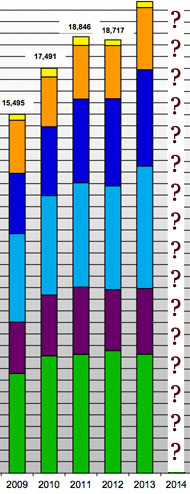Did cycling in New York City continue to rise in 2014? We still don't know, because NYC DOT has yet to release its annual count.
Usually, by this time of year, NYC DOT has released its screenline bike count showing the year-over-year trend in cycling in the city core (specifically, the screenline count measures cyclists on the East River bridges, on the Hudson River Greenway at 50th Street, and at the Staten Island Ferry Whitehall Terminal). We're more than a quarter of the way through 2015, though, and the agency hasn't posted its stats yet.
For several years, DOT released the screenline count the same year the data was gathered, since the agency focuses on cycling activity during the peak months of April through October. The 2008 count came out in October, 2008. The 2009 count was released in November, the 2010 count in December, and the 2011 count in December as well.
The 2012 bike count came out in the middle of March, 2013, with the addition of stats measuring winter cycling activity. Then last year DOT didn't release it until Streetsblog posted an unauthorized copy in July.
It would not be shocking if center-city cycling plateaued or dipped slightly in 2014. The city didn't expand the bike network as much as in previous years, and the bike-share system stayed the same size.
DOT has not responded to Streetsblog's requests for the 2014 bike count, so for now, we're in the dark.
The screenline count has its shortcomings, since it doesn't capture bike activity outside the city core. At a New York Cycle Club event last September, Transportation Commissioner Polly Trottenberg said DOT has to improve the way it tracks bicycling throughout the city. With significant bike infrastructure upgrades in the works for streets like Queens Boulevard, 111th Street in Corona, and Bruckner Boulevard, developing better citywide metrics is increasingly urgent.
But the screenline count remains important and useful. It's the only hard and fast measurement of cycling activity that DOT conducts every year, providing a continuous benchmark stretching back to the 1980s.






